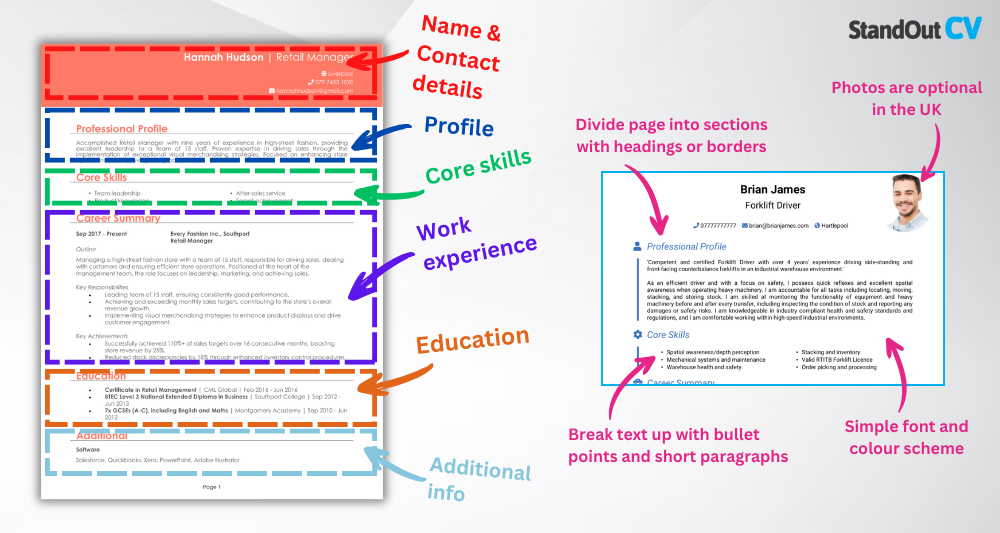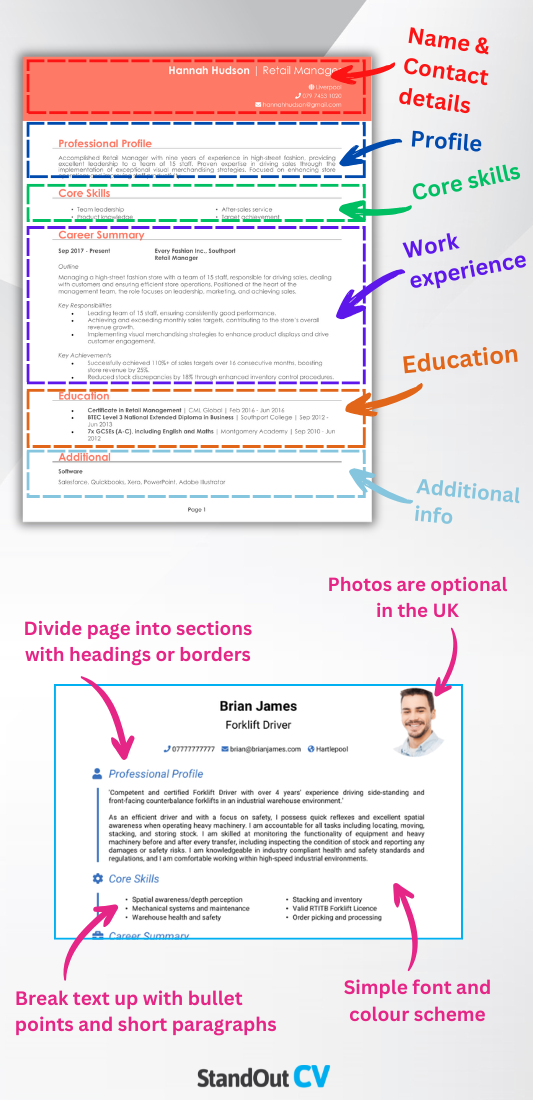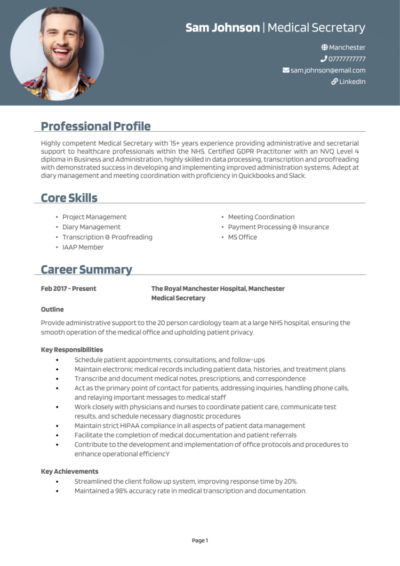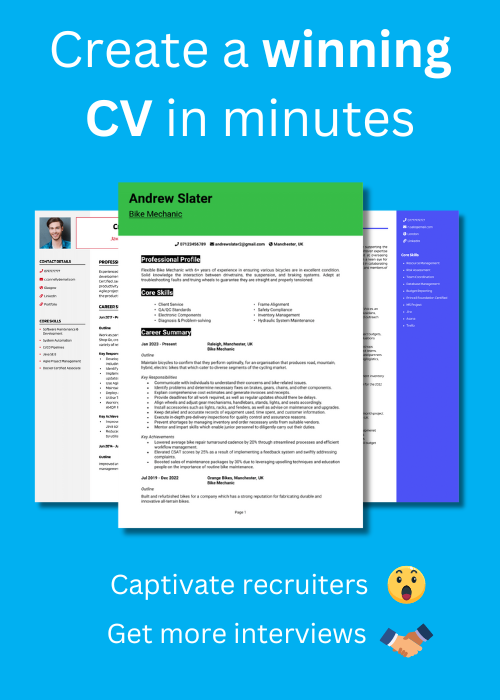There’s no room for error in a medical setting – and that includes your CV. Whether you’re managing appointment books or typing up consultants’ letters, the job demands precision and calm under pressure.
This guide and its Medical Secretary CV example will help you put together a polished application that reflects your organisational skills and medical admin experience, to increase your odds of landing the jobs you want.
Medical Secretary CV sample

How to write your Medical Secretary CV
Discover how to craft a winning Medical Secretary CV that lands interviews with this simple step-by-step guide.
You’re often the quiet linchpin holding an entire department together. From fielding patient calls to typing up sensitive documents, you keep everything running smoothly behind the scenes.
This guide will walk you through the exact formatting and content needed to write a CV that ticks all the right boxes for hiring managers.
How to structure and format your Medical Secretary CV


Just like in a medical environment, things need to be in the right place at the right time – you should structure your CV with that in mind. Employers don’t have time to dig through unstructured documents, so a clean, consistent layout will always work in your favour.
Here’s how it should be laid out:
- Name and contact details – Place your name and personal details prominently at the top of your CV for quick access. Adding a photo is up to you.
- Profile – Open with a compelling overview of your skills, experience, and career goals.
- Core skills – List your key abilities in this section, focusing on those that will be most relevant to the job.
- Work experience – Provide a detailed breakdown of your work history, starting with the most recent job first.
- Education – List your qualifications, including degrees and relevant certifications, in reverse chronological order.
- Additional info – Use this optional space for relevant hobbies or personal pursuits that enhance your application.
Use a professional and easy-to-read font, and break up longer sections with bullet points. Keep everything to a maximum length of two pages, and make sure your headings clearly mark each section. White space helps – don’t be afraid to leave some breathing room. And remember: the cleaner the format, the more capable it will appear.
How to write a Medical Secretary CV profile


Your CV profile should be sharp and tailored to the roles you’re applying for. It’s your opportunity to show that you can juggle admin tasks while remaining calm and professional in a clinical setting – whether you’re dealing with patients or their confidential records.
This section should focus on the value you’d bring to a healthcare team, rather than listing generic traits. Keep it direct and reflective of the real work you’ve done: you’ve only got a few sentences to convince recruiters that you’re worth hiring,.
Medical Secretary CV profile examples
Profile 1
Experienced Medical Secretary with over 10 years in private healthcare settings, supporting consultants in cardiology and general surgery. Adept at managing specialist clinic schedules, transcribing medical correspondence, and ensuring seamless communication between patients, doctors, and insurers. Known for maintaining confidentiality and efficiency under pressure, with strong command of systems such as EMIS and Medisoft.
Profile 2
Skilled Medical Secretary with six years of experience working in busy NHS outpatient departments. Has provided administrative support to multi-disciplinary teams, organised follow-up appointments, and managed patient databases. Proficient in SystmOne and Choose and Book, with a reputation for keeping clinics running smoothly and maintaining accurate patient records.
Profile 3
Reliable Medical Secretary with two years of experience in a cosmetic surgery clinic, assisting with patient intake, billing, and post-op follow-ups. Gained hands-on experience coordinating appointments, handling confidential documents, and responding to patient queries. Comfortable using Cliniko and standard Microsoft Office tools to manage clinic operations efficiently.
Details to put in your Medical Secretary CV profile
Include the following:
- Where you worked – Mention the healthcare environments you’ve worked in, such as GP practices, NHS hospitals, or private clinics.
- Your top qualifications – State if you hold any certifications in medical admin, healthcare support, or audio typing.
- Essential skills – Emphasise your ability to manage complex admin tasks, uphold confidentiality, and communicate effectively with both patients and clinical staff.
- The people you supported – Explain whether you worked for specific consultants, GPs, or administrative teams.
- Value delivered – Highlight your impact: whether that’s reducing appointment delays, improving admin turnaround times, or supporting smoother patient pathways.
What to include in the core skills section of your CV


A core CV skills section gives hiring managers a quick scan of your most relevant strengths – especially useful if they’re working through dozens of applications. Make sure everything you include aligns with the duties listed in the job description.
Focus on practical, tangible abilities that match the realities of medical secretarial work – from managing confidential data to preparing correspondence or supporting patient-facing roles. Avoid vague buzzwords and concentrate on the skills that truly matter in clinical admin roles.
What are the most important skills for a Medical Secretary CV?
- Medical Transcription and Dictation – Typing letters, reports, and clinical notes from audio recordings or handwritten drafts.
- Appointment Scheduling and Diary Management – Coordinating consultations, surgeries, and follow-ups using booking systems and calendars.
- Patient Record Management – Updating and maintaining accurate and confidential medical records in both paper and electronic formats.
- Referral and Correspondence Handling – Preparing referral letters, test requests, and correspondence between departments and healthcare providers.
- Telephone and Front Desk Duties – Answering patient queries, booking appointments, and handling calls with professionalism and discretion.
- Medical Terminology Proficiency – Understanding and correctly using clinical and anatomical terms in all written and verbal communication.
- Report Preparation and Filing – Compiling discharge summaries, test results, and other documentation for clinician review or external distribution.
- Confidentiality and Data Protection Compliance – Ensuring all patient information is managed in line with GDPR and NHS or private sector regulations.
- Billing and Insurance Administration – Processing invoices, insurance claims, and patient billing queries accurately and efficiently.
- Coordination with Clinical Teams – Liaising with doctors, nurses, and administrative staff to support seamless patient care and workflow.
How to write a strong work experience section for your CV


This is the most important section of your CV – it’s where you prove you can handle the pressures and expectations of medical administration. Your goal here is to show how you’ve supported healthcare delivery through solid organisation and attention to detail.
Detail your work experience in reverse chronological order. Start with a short summary of each job and its setting, then break your tasks and results into bullet points. Include responsibilities like managing records, scheduling procedures, and typing letters, as well as any improvements you made to workflow or communication, including other noteworthy achievements.
The best way to structure job entries on your CV

- Outline – Summarise the department, practice, or medical setting you worked in, and explain your place in the team.
- Responsibilities – Use action words like “coordinated” and “processed.” For example: “coordinated daily outpatient clinic lists for two consultants” or “processed incoming referrals and updated electronic records.”
- Achievements – Add value wherever possible. If you improved a system, reduced delays, or received praise from patients or staff, include that – even if it’s informal feedback.
Sample jobs for Medical Secretary
Medical Secretary | Elmhurst Aesthetic Clinic
Outline
Provided administrative support for a team of consultants at a leading private cardiology practice in London. Responsible for diary management, correspondence, and patient liaison using EMIS software to ensure smooth clinic operations.
Responsibilities
- Scheduled consultations, follow-ups, and procedures for four cardiologists, managing high-volume diaries
- Typed clinic letters, referral summaries, and insurance documentation with rapid turnaround
- Handled phone and email enquiries, ensuring a timely and professional response to patient needs
- Maintained accurate patient records and ensured compliance with data protection regulations
- Coordinated billing and liaised with insurers to process payments and authorisations
Achievements
- Reduced appointment scheduling errors by 45% through improved diary management processes
- Increased patient satisfaction scores by 20% through consistent communication and follow-up
- Implemented a new digital filing system, cutting admin time by 30%
Medical Secretary | Alderbridge NHS Trust
Outline
Supported clinical teams across dermatology and ENT departments at a busy NHS trust hospital. Used SystmOne and e-RS to manage bookings and provide administrative support to consultants and nursing staff.
Responsibilities
- Booked and confirmed appointments through e-Referral Service (e-RS) and managed rescheduling requests
- Typed up clinic notes, discharge summaries, and pathology requests using digital dictation
- Maintained accurate clinic templates and appointment slots to optimise workflow
- Collected and filed test results, ensuring availability for consultant review ahead of appointments
- Responded to patient calls regarding test results, referrals, and appointment logistics
Achievements
- Helped cut clinic backlog by 15% through improved triage and slot allocation
- Played a key role in transitioning the department to digital records with minimal disruption
- Recognised with a departmental award for outstanding administrative support during peak demand
Medical Secretary | Veritas Cardiology Group
Outline
Worked at a private cosmetic surgery clinic providing front-line administrative support to surgeons and patients. Managed bookings, handled client communication, and maintained confidential medical records using Cliniko.
Responsibilities
- Greeted patients, checked them in, and ensured all pre-operative paperwork was completed
- Scheduled surgeries and consultations while coordinating operating theatre availability
- Liaised with suppliers and managed inventory for post-op care materials
- Processed payments and issued invoices for treatments and follow-ups
- Updated and organised client files in line with GDPR and clinical governance standards
Achievements
- Increased clinic efficiency by introducing online booking reminders, reducing no-shows by 35%
- Supported launch of new treatment packages by coordinating scheduling and admin materials
- Managed patient feedback process, leading to a 4.8-star clinic rating on review platforms
How to list your educational history


While formal education plays a supporting role in admin-heavy roles like this, it still matters – especially if you’ve completed a qualification specific to medical or legal administration.
List your education in reverse chronological order, starting with the most recent. If you’ve taken courses in audio typing, medical terminology, or NHS systems, mention them clearly. No need to list every module, but ensure the relevance is obvious.
What are the best qualifications for a Medical Secretary CV?
- Level 2 or 3 Diploma in Medical Administration – Focused on healthcare-specific admin skills
- City & Guilds Level 2 in Business and Administration (Medical) – Offers recognised admin training within a medical context
- OCR/RSA Audio Transcription Certificate – Demonstrates fast, accurate transcription skills
- NHS IT Systems Training (e.g. EMIS, SystmOne) – Essential for most primary care or hospital roles
- GCSEs (including English and Maths) – Minimum requirement for most admin roles in the NHS and private sector





